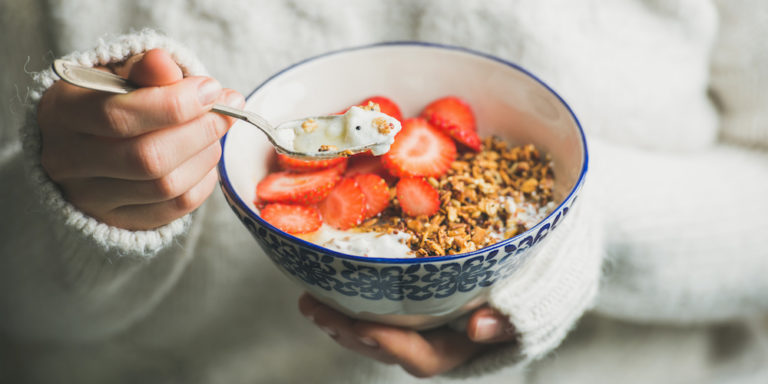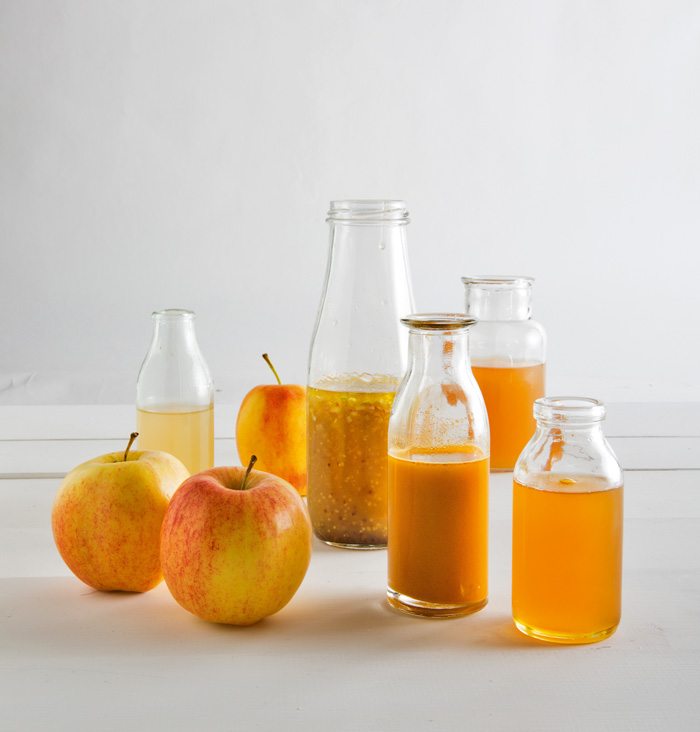As we are becoming increasingly aware, the traditional debate surrounding sugar versus fat in our diets has been misguided. It has been recently revealed that powerful scientific research regarding nutrition was influenced by the food industry to blame fats in the diet for diseases such as obesity, diabetes and heart disease while ignoring the role of sugar (Bero, 2016).
With Western societies are encouraged to avoid fats in their diets, foods that became marketed as being ‘low fat’ were perceived as ‘healthy’. However, what we are now learning is these so-called ‘healthier’ options may be doing us more harm than good, as high amounts of sugar is often injected into these products in order to improve flavour. What’s more, without a clear labelling system on packet foods, consumers are unwittingly ingesting these sugars as part of what they believe to be a healthy diet.
That Sugar Film
In 2014, Australian actor Damon Gameau conducted an experiment. Having given up sugar for several months, Gameau wondered how sugars were still finding their way into the national diet. “The World Health Organization recommends eating no more than six teaspoons of sugar per day, but many Australians unwittingly consume up to 40 teaspoons of sugar per day, by eating everyday foods,” he says.
What astounded Gameau was these sugars were not generally consumed through traditional routes such as discretionary (junk) foods or soft drinks. Rather they were hidden among so-called healthy foods.
To uncover the hidden sugars in these foods, Gameau went on a diet for 60 days. Under medical supervision, he included 40 teaspoons of sugar a day. He documented the process and created his film, That Sugar Film, to capture the process.
The rules of the experiment meant Gameau would not be eating more calories than he would normally (about 2300 per day). Instead, he would just change the calorie source. As a result, rather than adhering to his regular diet of healthy fats, low carbohydrates and no sugar, he would feast on foods that were marketed as ‘low fat’. He also maintained his regular exercise regime.
After two days, Gameau was surprised at how easy it was to consume the national average – 40 teaspoons – of sugar a day. Instead of bacon, avocado and eggs for breakfast, he was eating a ‘healthy’ branded cereal with low-fat yoghurt and a glass of orange juice – a meal comprising an incredible 20 teaspoons of sugar. Snacks of nuts, whole fruits and cheeses were replaced with processed foods such as muesli bars and fruit smoothies.
The results were striking. After 12 days, Gameau had put on 3.2 kilos of visceral fat – the kind that collects around the abdomen and attaches itself to key organs such as the liver, pancreas and intestines. An examination of Gameau’s liver also found that the ALT enzyme was in his blood – an indicator that his liver cells were being overloaded with fat and were essentially dying. His pathologist Dr Ken Sikaris explained the excess sugar that was now in Gameau’s diet was causing havoc in his liver, particularly fructose. At the end of the experiment, Gameau had gained 8.5 kilos, and his waist had increased by 10 centimetres, not to mention the increased risk of diabetes, and liver and heart disease.
Sickly sweet
While Gameau’s experiment may seem out of the ordinary for the everyday person, it dramatically highlights just how much sugar is hidden in our foods. Executive manager of the Australian Obesity Policy Coalition (OPC), Jane Martin, says the situation is more common than we think. “Some people often ask, ‘Why aren’t we eating well?’ This is a classic example of people trying to eat well and being misled by business.” Martin has a strong history of working in public health, and previously worked in tobacco control for more than 20 years, overseeing the Victorian implementation of the Quit campaign.
She says she was motivated to move from tobacco control into the growing area of obesity as she could see parallels between the two. “I could see how my children were being targeted by industry,” she says. “I really felt that the work that we did in tobacco control needed to start happening.”
The OPC has been working with government and industry bodies to use the Australian legal framework surrounding food labelling, advertising and other laws that impact obesity, to help combat the current epidemic. Martin says we are unwittingly inundated with products claiming to be healthy but that are packed with sugar.
“People are very motivated to eat healthily. That’s why we are drawn to these sorts of products,” she explains. “Then if you look at the kind of cues we are getting from the packaging, it’s all to reinforce this idea.” Martin says these products contain a lot of subtle messaging to entice consumers to think they are buying a healthy product.
Products will often be promoted with terms such as ‘natural’, ‘healthy’, ‘low fat’, and ‘high fibre’. Visual cues such as pictures of whole fruit and vegetables, grains, plants and rating systems with ticks and stars are also used to conjure a positive association. “It is subtle but there are many cues on the packaging which are there to make you think you are buying a healthy product.”
A Worldwide Problem
Just as obesity and diet-related disease are a global problem, so too is the issue of hidden sugars. A 2015 Canadian study found processed and packaged foods regularly contained a high amount of added sugar. The study published in CMAJ Open examined the ingredients of 40,829 packaged foods and beverages sold at national supermarket chains of a major Canadian grocery retailer.
Researchers found 66 per cent of these products had added sugar in their ingredients list. Consistent with Australian findings, this research included many foods perceived as healthy such as yoghurt, breakfast cereals, snack bars and juice. Even some infant formulas and baby foods were found to have added sugars.
“People may be surprised to learn how many packaged foods and beverages have sugars added to them, especially foods that most would consider ‘healthier’,” says Dr Erin Hobin, a scientist specialising in chronic disease and injury prevention, and an author of the study.
“We found that the majority of products frequently marketed as healthy options like granola bars or yoghurt also listed added sugars in their ingredients. In addition, almost half of all infant formulas and baby food we studied listed added sugars as part of their ingredients.”
Meanwhile, a 2017 study conducted by Public Health England found British children are consuming half of their recommended maximum daily intake of sugar at breakfast alone. Despite this, many parents believed their children’s breakfast was healthy. These studies show there is a clear disconnect between what the public perceives to be healthy and what truly is.
Why this is an Issue
Added sugars are particularly concerning as they tend to be consumed in much larger quantities than naturally occurring sugars found in foods such as bananas or a glass of milk. Sugars are often added to a product at the expense of other essential nutrients, which increases the overall energy density of diets.
This can have serious health impacts for anyone trying to maintain their blood sugar or weight levels, particularly people prone to insulin resistance and type 2 diabetes. What’s more, as the researchers of the Canadian study note, there is growing evidence indicating the excess consumption of sugar is associated with a variety of health problems including heart disease, obesity, stroke, diabetes, cancer and dental cavities.
Tools available that can help figure out the nutrition labels include the Food Switch App, which scans the barcode of a product, then gives you a nutritional profile; the OPC “Live Lighter Wallet Guide” is available at livelighter.com.au, offering a wallet carry-card that gives a breakdown of safe amounts of fats, sugar and salt; and That Sugar App – by the makers of the film – which allows users to look up the amount of sugar in a product. You can also set a personal ‘sugar challenge’ to help track the amount of sugar in your diet.
The Devil is
In the Detail
While it is compulsory for manufacturers to list their ingredients on food products, it is clear that the current method is confusing and misleading for consumers who are trying to ascertain whether a product is actually healthy. “If you are a single mum and time poor and you just want to get something that your kids will eat, you don’t have time to decipher a nutritional panel,” empathises Martin.
In Australia, the government has implemented the food Health Star Rating on packaged foods. The system is about to be adopted in New Zealand. Martin and the OPC worked with government and industry on getting the system implemented in Australia. She says that in their current form, the stars are helpful in encouraging people to be aware of what they are eating, but there is room for improvement. “They don’t necessarily mean that the product is healthy, they are a way to determine whether that product is healthier than another product in that category,” she explains. “So they will guide you to a healthier nutritional profile but they are on processed packaged food, which are unhealthy foods overall.” Currently in Australia, display of the star ratings is voluntary, with many companies who sell products that would have a low nutritional profile, choosing not to display the rating. Also, the current algorithm used by the rating system is quite generous with added sugars, which is not especially helpful for consumers.
A Way Forward?
If consumers are to take responsibility for their health and make informed nutrition sources, they need clear and consistent nutritional information about the foods they buy.
In 2009, Australia and New Zealand food regulation ministers agreed to a comprehensive independent review of food labelling law and policy. The final report was released in 2011 and contained several recommendations, including a provision where all “added sugars” to a product be clearly labelled as a group, followed then by the most specific ingredient term (e.g. “added sugars” (fructose, honey, etc).
This move has yet to be adopted by either the Australian or New Zealand governments but similar action has just taken place in the United States. Here, companies are now required to clearly list when sugars have been added to a product.
Consumers are encouraged to read the nutritional labels of all processed foods, even those we may not traditionally consider to contain sugar.
What do we mean by ‘free sugar or
added sugar’?
“Added sugar” generally refers to sugars that are added to foods and beverages during preparation or processing. WHO defines “free sugars” as all “monosaccharides and disaccharides added to foods and beverages by the manufacturer, cook or consumer, and sugars naturally present in honey, syrups and fruit juices”.







